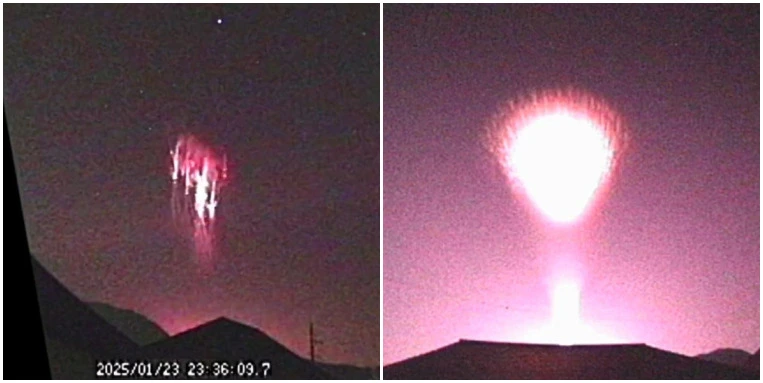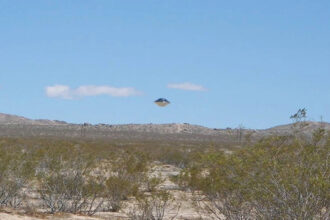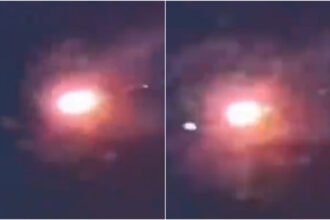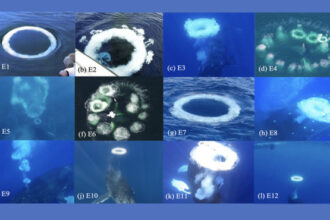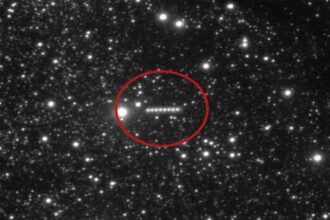“Gigantic jets” are a rare atmospheric phenomenon consisting of massive electrical discharges, similar to lightning, that extend from the tops of storms or volcanic eruptions to the ionosphere, at an altitude of 50 to 90 kilometers. They represent a form of tropospheric lightning that escapes from storm clouds or volcanic plumes into space, creating an impressive visual spectacle with significant scientific relevance.
These events typically arise under specific conditions, such as intense storms or explosive volcanic eruptions, when the plume of ash and gases acts as a conductor for electrical discharges. Visually, gigantic jets resemble inverted lightning bolts ascending toward the ionosphere, displaying bluish or violet tones near the plume and reddish hues at their upper ends. Despite lasting only a few milliseconds, their energy is intense enough to temporarily alter ionospheric conditions. They are also associated with other high-altitude phenomena, such as sprites, elves, and blue jets.
In the case of volcanic eruptions, the formation of gigantic jets is facilitated by factors such as electrically charged volcanic ash, particle collisions within the plume, and ionized gases. These elements create the ideal conditions for the volcanic plume to function as a conductive channel between the surface and the upper atmosphere, significantly increasing the likelihood of discharges. These phenomena not only enhance our understanding of the interaction between the troposphere and the ionosphere but also highlight the potential impacts of volcanic events on electrical and communication systems. (Source)
In 2008, a significant breakthrough in the study of “gigantic jets” was achieved by a team from Duke University in North Carolina, led by Steven Cummer. Using an automated recording system to monitor lightning’s magnetic activity, the group initially aimed to study “sprites,” another type of luminous discharge in the upper atmosphere. However, during the passage of Tropical Storm Cristobal on July 21, the team managed to capture a rare gigantic jet emerging from a storm, marking a decisive moment in the research on this phenomenon.

Upon analyzing the captured data, the scientists determined that the gigantic jet carried an impressive electric charge of 144 coulombs, comparable to the most powerful lightning strikes that hit the ground. This intensity is 100 to 1,000 times greater than that of typical lightning. The discovery provided unprecedented evidence that gigantic jets establish direct electrical contact with the ionosphere, the upper layer of the thermosphere, transporting significant amounts of charge from the troposphere to the upper atmosphere. “Until then, we didn’t know if gigantic jets were actually electrically connected to the ionosphere. Learning that they carry such intense charges was surprising,” said Cummer.
Published in Nature Geoscience in August 2009, this research highlighted the scientific relevance of gigantic jets, not only due to their electrical power but also for their contribution to understanding interactions between different atmospheric layers. These findings marked a starting point for further studies, emphasizing the need to delve deeper into the impacts of this rare and still poorly understood phenomenon. (Source)
And today, on the 24th, rare and fascinating examples of the “gigantic jet” phenomenon, along with sprites, were recorded on Mount Fuji, Japan. The images were shared by Daichi Fujii, curator at the Hiratsuka City Museum and responsible for the astronomy department, on his X (formerly Twitter) account. Fujii is renowned for his observations of meteors, lunar impact flashes, sprites, phenomena related to Mount Fuji, artificial satellites, among others. Passionate about space exploration, he also dedicates himself to studying and following the history of rockets and artificial satellites.
先ほど非常に大きな発光現象が発生しました!2025年1月24日1時23分16秒に、富士から南に向けたカメラで撮影した様子です(スロー再生)。高高度発光現象の一種で、おそらく巨大ジェット (gigantic jet)だと思われます。このほかにも、23時から0時台に大規模なスプライトが相次ぎました。 pic.twitter.com/UiEyIfuUi8
— 藤井大地 (@dfuji1) January 23, 20252025年1月24日1時23分16秒の巨大ジェットと思われる発光現象を、平塚から撮影した様子です。平塚は根元の雷が写り、宇宙に向かって伸びているのがわかります。 pic.twitter.com/H8KaHJEtxR
— 藤井大地 (@dfuji1) January 23, 2025At least two recordings were shared by Curator Daichi Fujii on his X account. A large luminous phenomenon occurred on Mount Fuji, Japan, on January 24, 2025. The first photo was taken with a camera pointing south of Fuji at 1:23:16, showing a high-altitude luminescent phenomenon, likely a gigantic jet, in slow-motion. In addition, large-scale sprites were observed appearing one after another between 11:00 PM and 12:00 AM.
Another image was captured from Hiratsuka at 1:23:16 on the same day, showing a light emission phenomenon that appears to be a gigantic jet. In the photo, a lightning bolt can be seen at the base of Hiratsuka, extending into space.
The same phenomenon also appears to have been recorded by the Astronomy and Meteorology Club of Tachikawa Metropolitan Senior High School, which also shared images from a different angle of the event. The club provided additional footage, offering a different perspective on the luminous phenomenon, which seems to have occurred simultaneously in the region.
2025年1月24日1時23分16秒に南向きカメラで巨大ジェットと思われる高高度発光現象を観測しました! pic.twitter.com/LKodDKsC5h
— 都立立川高校天文気象部 (@tamc_net) January 23, 2025As already mentioned, in addition to gigantic jets, sprites were also recorded, making the event even rarer, as they are similar phenomena but distinct. Gigantic jets are electrical discharges that extend from the top of clouds to the ionosphere, reaching altitudes of up to 90 km. They move toward space, carrying large amounts of electrical charge into the upper atmosphere.
On the other hand, sprites are bursts of light that occur in the upper troposphere, usually around 50 to 90 km in altitude, and appear as large red flashes. Although both are high-altitude luminous phenomena, the main difference lies in the direction and nature of the electrical discharges: while gigantic jets move toward space, sprites illuminate the region between the clouds and the ionosphere.
The sprite recording was recently shared by the curator of the astronomy museum, who stated: “This is an image of a sprite captured by a camera facing southwest from Fuji, between the evening of January 23 and the early morning of January 24, 2025. The video is playing at 1/4 speed, and the numbers below indicate the time of occurrence. In addition, a gigantic jet was recorded in the south, and Elves appeared in the southeast, making the sky quite busy.”
2025年1月23日夕方から24日未明にかけて発生したスプライトを、富士から南西向きのカメラで捉えた様子です。1/4倍速で続けて再生し、下の数字が発生時刻を示しています。このほかにも、南で巨大ジェット、南東でエルブスが発生し、大賑わいの空でした。 pic.twitter.com/k57uWqCxU1
— 藤井大地 (@dfuji1) January 24, 2025It is still unclear whether these phenomena are somehow linked to the activity of Mount Fuji, which has not erupted in 300 years. In any case, these exceptional recordings could significantly contribute to the understanding of these rare phenomena and help science expand its limited knowledge about them.




